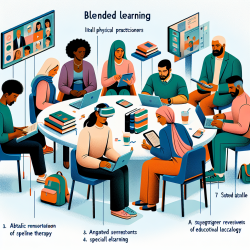Blended Learning (BL) is increasingly recognized as a transformative approach in education, combining face-to-face (F2F) and online settings to enhance student engagement and learning outcomes. A recent systematic review of systematic reviews by Ashraf et al. (2021) provides a comprehensive analysis of BL trends, challenges, and future directions. This blog aims to help practitioners improve their skills by implementing the outcomes of this research or by encouraging further exploration.
Key Findings and Their Implications for Practitioners
1. Understanding Blended Learning Trends
According to the review, BL has been predominantly explored in higher education, particularly in developed countries like China and the United States. This highlights the need for cross-country collaboration to facilitate BL adoption in regions with limited infrastructure. Practitioners can:
- Engage in professional networks to share BL resources and strategies.
- Advocate for policy support to enhance ICT infrastructure in their institutions.
2. Addressing Subject-Specific Applications
While BL is widely used in health and STEM subjects, there is a need for more research in other areas such as mathematics and language learning. Practitioners should:
- Explore BL models that can be tailored to specific subject needs.
- Collaborate with colleagues to develop interdisciplinary BL strategies.
3. Focusing on Key Stakeholders
The review found that most studies target students and teachers, often neglecting policymakers. To advance BL adoption, practitioners should:
- Engage policymakers in discussions about BL benefits and requirements.
- Participate in professional development programs focused on BL policy and implementation.
4. Enhancing Research Methods
The majority of studies conducted systematic reviews with qualitative analysis. Future research should incorporate quantitative methods to provide a more nuanced understanding of BL effects. Practitioners can:
- Participate in or conduct action research to gather quantitative data on BL outcomes.
- Use evidence-based practices to refine BL implementation in their classrooms.
5. Implementing Effective BL Models
The flipped classroom model is the most frequently implemented BL model, particularly in health and STEM subjects. Practitioners should:
- Adopt and adapt the flipped classroom model to suit their teaching context.
- Utilize online resources and F2F interactions to maximize student engagement and learning.
6. Overcoming Challenges
Common challenges in BL include a lack of ICT skills, infrastructure issues, and course preparation time. Practitioners can address these by:
- Engaging in ICT training programs to enhance their technical skills.
- Advocating for improved ICT infrastructure in their institutions.
- Collaborating with colleagues to share BL resources and reduce preparation time.
Conclusion
Blended Learning offers numerous benefits, but its implementation requires careful consideration of various factors. By understanding the trends, addressing subject-specific needs, focusing on key stakeholders, enhancing research methods, implementing effective BL models, and overcoming challenges, practitioners can significantly improve their skills and contribute to the advancement of BL in education.To read the original research paper, please follow this link:
A Systematic Review of Systematic Reviews on Blended Learning: Trends, Gaps and Future Directions.










